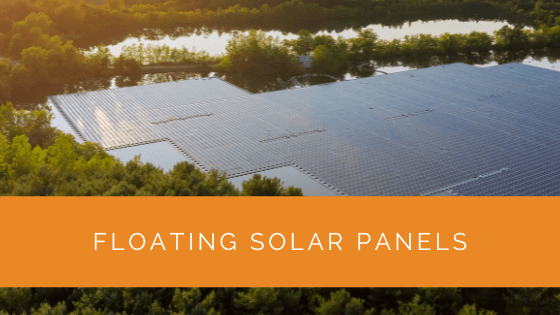In the ever-evolving world of renewable energy, floating solar panels, also known as “floatovoltaics,” are making a significant splash. These innovative solar systems are not your typical rooftop installations or expansive ground-mounted arrays. Instead, they gracefully rest on the surface of ponds, lakes, and reservoirs, providing an environmentally friendly, space-efficient, and highly efficient alternative to traditional solar setups.
Floating solar panels have been making waves, boasting approximately 10% greater efficiency than their land-based counterparts. Beyond their energy-generation capabilities, these floating wonders offer many benefits, from preserving valuable land space to promoting a healthier environment. This article dives deep into floating solar panels, exploring their components, working mechanisms, costs, advantages, disadvantages, and exciting potential in sustainable energy solutions. So, let’s embark on a journey to discover the future of solar excellence with floating solar panels!
Contents
- 1 Key Takeaways
- 2 Floating Solar Panels: What Are They?
- 3 Need for Floating Solar Power
- 4 What Forms a Floating Solar Panel?
- 5 How Do Floating Solar Panels Work?
- 6 Costs and Installation
- 7 Are There Any Disadvantages of FPVs?
- 8 Comparison Between Ground-based and Floating Solar Plants
- 9 Case Study: Implementing Floating Solar Panels for Enhanced Energy Efficiency
- 10 Expert Insights From Our Solar Panel Installers About Floating Solar Panels
- 11 Experience Solar Excellence with Us!
- 12 Explore Your Solar Options
Key Takeaways
- Floating solar panels, known as “floatovoltaics,” are an emerging technology in the solar industry. They are mounted on floating structures and placed on stagnant water bodies, offering several advantages over traditional ground-based solar panels.
- Advantages of floating solar panels include increased power generation due to the cooling effect of water, preservation of valuable land space, a healthier environment with benefits like reduced evaporation and prevention of algae growth, and low maintenance compared to ground-based systems.
- While floating solar panels can be costly, they provide a sustainable and efficient source of clean energy. They are particularly well-suited for large-scale projects in regions with water bodies. They are an up-and-coming technological development in the renewable energy sector.
Floating Solar Panels: What Are They?
Floating photovoltaics or floatovoltaics are emerging technologies in the solar industry. These solar panels are mounted on floating structures and hover on stagnant water bodies like ponds, lakes, and reservoirs.
Floating solar panels have shown about 10% greater efficiency than traditional on-ground solar panels. They also come with a tremendous environmental impact, thus boosting the ecosystem.
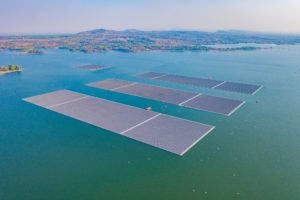
Need for Floating Solar Power
You might face various challenges while installing solar panels for domestic use. Your rooftop might lack space, or there might be shade or obstructions to sunlight.
People opt for solar canopies or ground mounts for larger projects. Also, full-scale solar power plants take up anywhere between ten to a hundred acres of land. Owners could otherwise use this land could otherwise be used for agriculture or industrial purposes.
Installing floating solar panels can be the solution to all these problems.
Here are some advantages of a floating array plant that extend beyond energy generation.
Increased Power Generation
In high temperatures, the efficiency of a land-based solar array decreases. This characteristic is a significant concern for people living in regions with a hot climate, which has the best potential to create solar energy.
Floating solar panels do not face this problem. The water body they float on provides a cooling effect, thereby maintaining their performance in all temperatures. Thus, on the whole, floating solar panels are more efficient than the ones on land.
Valuable Land Space Preserved
The most obvious benefit of floating solar is that there is no loss of land space. These panels are usually on unused and stagnant water bodies like wastewater treatment ponds, drinking water, or hydroelectric dams and reservoirs.
Thus, landowners can repurpose their properties and contribute to the economy in other ways. Plus, there is no longer a need for land clearing or cutting down trees to make space for solar array installations.
Healthier Environment
A floating PV array does not just take energy from the sun. It also gives back to the environment a slew of benefits.
- Renewable Energy: These solar panels are a clean, green energy source. They mitigate the effects of pollutants and greenhouse gases, making the environment safer for all life forms.
- Reduced Evaporation: In hot regions, water bodies dry up very quickly during summer. Having floating solar panels on the water surface of reservoirs and lakes prevents water loss or draughts in susceptible areas.
- Prevents Algae: Freshwater contamination from algae blooming is curbed by the presence of floating panels. This keeps the water fit for human consumption and helps aquatic plants and animals.
Low Maintenance
Ground-based solar systems require frequent maintenance due to overheating issues. They also demand regular land upkeep instead of floating solar projects, which are way easier to maintain.
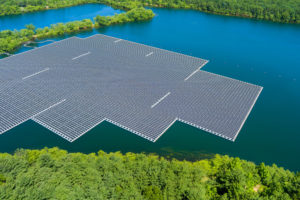
What Forms a Floating Solar Panel?
The construction of floating solar power plants involves a fair share of shore and in-water work. A floating solar array requires a stable platform for mounting. The floats are put together on land and then sent into the water to be arranged.
The following are the nine components of a floating PV system.
PV modules
A panel of connected PV cells harnesses the sun’s energy and converts it into viable form. They are the drivers of any floating solar array.
Floaters
They are the plastic rafts or pontoons that carry the solar panels on the water. A stable floater protects the solar panel from any moisture-related harm.
Electrical Safety Anchoring and Mooring System
Floating arrays are anchored using a mooring system. The process requires cabling, making the float adaptable to changing water levels.
Anchors are present at the water’s bed and provide additional support to the floaters. Vertical load, suction anchors, and drag embedded are commonly used anchor types.
Mooring lines connect the floater to the anchor below. The choice of mooring line depends on the weight of the PV panels to be carried. Choosing the right one will help you avoid any mooring issues.
Combiner Box and Central Inverter
An electrical dispersal box that holds the DC breakers. It merges the DC outputs from all the individual solar panels into a single output. The inverter converts the DC to AC to be transmitted as electrical energy to nearby houses.
Transformer
A transformer increases the voltage for easier electricity transmission through long distances.
Cabling and Transmission System
The electrical wiring integrates the solar panels, combiner, inverter, and transformer. Inverters are usually placed on the shore to ensure electrical safety and make the cables less susceptible to water damage. The connection line carries solar-generated electricity wherever needed.
Floating Walkways
Walkways are an essential maintenance feature. They provide a direct path to access the panels from the inland whenever they need servicing.
How Do Floating Solar Panels Work?
Floating solar panels function similar to the ground-based panels except for a few minor differences.
The photovoltaic solar cells on the panels are hit by sunlight, causing the excitation of electrons within the semiconductor. The movement of these energized electrons creates an electrical current.
The output from the panels travels to the combiner. DC circuit breakers are placed in its path to secure the system against any overloads. All DC outputs are merged into a single DC signal and sent to the inverter in the combiner.
The inverter converts the DC signal to AC. The AC is then stepped up using a transformer to carry over long distances without significant losses. The transmission line ensures that the current reaches the people who need it!
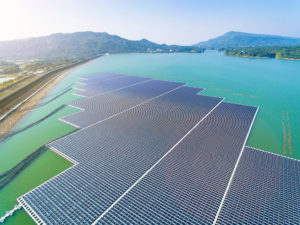
Costs and Installation
After garnering information on the working of these fantastic systems, you might be interested in installing one yourself! Here is everything you need to know!
How Much Does Floatovoltaics Cost?
Floating solar panels can be costly. Almost half the price of the entire system is just for the floaters.
Assembling 1 Megawatt floating solar power plants can cost you $1 to $1.2 million. Yes, that is a mammoth amount, but you do not have to spend repeatedly and enjoy many cost benefits.
Quick Tip: Set up your floating solar plants in a pre-existing hydrothermal power plant. This way, you will not have to spend on transmitting and distributing the power generated.
Installing Floating Photovoltaic Panels
The design for your floating solar power plant will differ based on these factors.
- PV module type available to you
- Function of the water body
- Orientation of your solar panels
- Water coverage needed for your plant
The process of installation begins with anchoring. It ensures the longevity of your system. Deep holes are dug in the seafloor. The anchors are inserted until they are far down enough to be stable. They must hold the weight of the floaters and the solar panel.
The next step is to arrange floaters on the water surface. Then, a mooring line connects the floater to the anchor to remain fixed in an optimum sunlight-seeking position.
Then, you install floating solar panels on the floater and make the necessary electrical connections. Once the system is installed, the construction of floating walkways alongside the panels comes.
You need to hire a team of qualified marine engineers and solar technicians to install a complete floating solar power plant or even a smaller floating solar project. Without the technical know-how, you might encounter problems with your setup.
Are There Any Disadvantages of FPVs?
This one’s a crucial pointer! While the advantages are in heaps and bounds, this technology has certain drawbacks, too.
Firstly, the initial cost can be a tad bit high. Setting up a floating solar power plant requires capital. These solar projects tend to be large-scale. There is no feasible alternative for household use yet. They remain an excellent project for large communities or companies worldwide.
Secondly, cleaning the panels can be a hassle. Although a solar plant is inexpensive to maintain, it still needs regular attention in terms of cleaning. In comparison to ground-based panels, that might seem inconvenient.
Lastly, if the placement of the floating panels is not planned correctly, it may cause a shortage of sunlight in the deeper reaches of the water body. There is a practice guide to follow to avoid these cases.
People also tend to have concerns about corrosion of the panels. Built specifically for the water, floating solar panels are coated with corrosion-resistant materials. This makes them extremely water-friendly. They can even survive frozen water.
Although they could be installed in moving water, they will wear out faster. Installing them on calm waters, like lakes or man-made bodies like ponds, is recommended. Dam reservoirs are even better. This will prevent any possible harm from excessive water or waves.
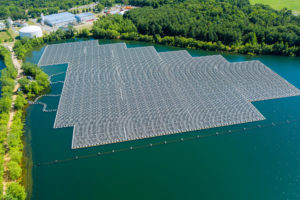
Comparison Between Ground-based and Floating Solar Plants
Floatovoltaics are an ideal solution to the problems with conventional solar panels. Here is a quick summary of the differences between the two.
- Space Required: A 1MW capacity floating PV power plant needs around 5-10 acres to be set up on land. On the other hand, a 1MW capacity floating solar power plant needs only around 2 acres of space.
- Ease of Installation: Traditional systems are easier to install. They are also easy to access for servicing. FPV installation involves working inside water, which can be more complicated than land-based installations.
- Maintenance: Repeated maintenance is required due to overheating issues for conventional PV arrays. Water has a natural cooling effect and prevents overheating of the floating PV system.
- Performance: Land PV performance can be dampened by electrical heating. FPV has higher efficiency consistently.
Case Study: Implementing Floating Solar Panels for Enhanced Energy Efficiency
Background
At Solar Panels Network USA, we are committed to providing innovative and sustainable solar energy solutions. One of our recent projects involved the implementation of floating solar panels on a municipal water reservoir. The local government sought a renewable energy solution that would not only generate clean energy but also address water conservation concerns.
Project Overview
The project aimed to install a floating solar power system on a large, unused reservoir to generate electricity for municipal use and reduce water evaporation. The client required a solution that was both environmentally beneficial and cost-effective over the long term.
Implementation
Our team undertook a comprehensive approach to design and install the floating solar system:
- Site Assessment: We conducted an extensive assessment of the reservoir, analyzing water depth, surface area, and sunlight exposure to determine the optimal placement for the floating solar panels.
- System Design: Leveraging our expertise, we designed a floating solar array consisting of high-efficiency PV modules mounted on durable floaters. The system was configured to maximize energy production and ensure stability on the water surface.
- Installation Process: The installation involved anchoring the floaters securely to the reservoir bed using a robust anchoring and mooring system. This ensured the stability of the solar panels and allowed for adjustments in water levels. Electrical connections were meticulously planned to integrate the system with the existing power grid, ensuring seamless energy transmission.
- Maintenance Plan: We provided a detailed maintenance plan, including regular inspections and cleaning schedules to ensure the longevity and optimal performance of the floating solar system. Floating walkways were installed to facilitate easy access for maintenance personnel.
Results
The implementation of the floating solar panels yielded remarkable results:
- Increased Energy Efficiency: The cooling effect of the water surface enhanced the efficiency of the solar panels, resulting in approximately 10% higher energy output compared to traditional land-based systems.
- Water Conservation: The floating solar panels significantly reduced water evaporation, conserving a substantial amount of water in the reservoir. This benefit was particularly valuable during the hot summer months.
- Environmental Benefits: The presence of the solar panels helped prevent algae growth, improving the water quality and supporting local aquatic life. Additionally, the system contributed to reducing greenhouse gas emissions by generating clean, renewable energy.
- Cost Savings: By utilizing an existing water body, the project avoided the costs associated with land acquisition and preparation. The long-term maintenance costs were also lower due to the natural cooling effect reducing the wear and tear on the panels.
Summary
Our experience with the floating solar panel project underscores the significant advantages of this innovative technology. By utilizing unused water surfaces, we were able to enhance energy efficiency, conserve water, and provide environmental benefits. Floating solar panels represent a promising solution for municipalities and large-scale energy consumers seeking sustainable and cost-effective renewable energy options. At Solar Panels Network USA, we are proud to lead the way in implementing cutting-edge solar technologies that make a positive impact on the environment and our clients’ energy needs.
Expert Insights From Our Solar Panel Installers About Floating Solar Panels
Floating solar panels offer a unique advantage by leveraging unused water bodies for energy production, which not only preserves valuable land space but also enhances the efficiency of solar cells through natural cooling.
Senior Solar Technician
The installation of floating solar panels can significantly reduce water evaporation and inhibit algae growth, making them an environmentally friendly solution that also supports water conservation efforts.
Lead Solar Engineer
One of the key benefits of floating solar systems is their versatility and adaptability, especially in regions where land availability is limited or costly. This innovative approach maximizes renewable energy generation without compromising land use.
Solar Installation Specialist
Experience Solar Excellence with Us!
Trust in Solar Panels Network USA, where our seasoned experts deliver top-quality solar solutions for homes and businesses nationwide. With a legacy of countless successful installations and a commitment to sustainable energy, we’re your reliable partner in the solar journey. Ready for a brighter, eco-friendly future? Call us now at (855) 427-0058 and harness the sun’s power!
Explore Your Solar Options
Remember, your new floating solar plant can be installed in integration with an existing hydroelectric plant to save on initial costs. You get a reservoir to tap into, and the reservoir also benefits from the project’s environmental benefits.
Also, your floating solar panels might seem like regular PV cells but are slightly enhanced. They are modified to be water and freeze-resistant.
Floating solar plants are in their infancy. This technology has yet to grow to its full potential, but it seems like an up-and-coming technological development.
If you are looking for clean, renewable energy investments, this is a step in the right direction!
About the Author
Solar Panels Network USA stands at the forefront of solar energy solutions, driven by a team of seasoned solar engineers and energy consultants. With over decades of experience in delivering high-quality solar installations and maintenance, we are committed to promoting sustainable energy through customer-centric, tailored solutions. Our articles reflect this commitment, crafted collaboratively by experts to provide accurate, up-to-date insights into solar technology, ensuring our readers are well-informed and empowered in their solar energy decisions.

